Understanding Ideal Depth for Round Diamonds
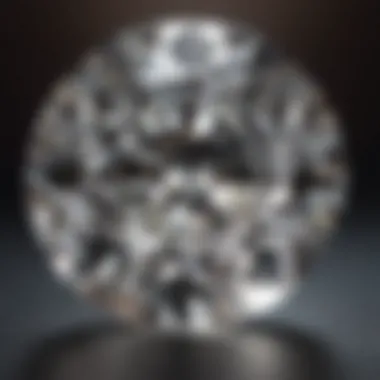
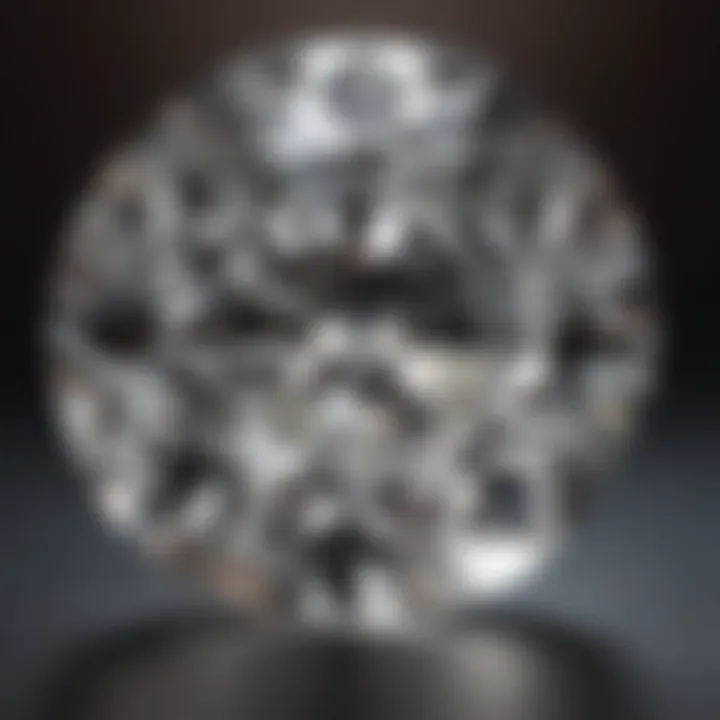
Intro
The ideal depth of round diamonds plays a critical role in their brilliance and overall aesthetic appeal. Understanding this aspect of diamond quality can significantly influence consumer choices. This section aims to establish a foundation for the various factors surrounding diamond depth, setting the stage for deeper exploration into the metrics that contribute to cut quality and beauty.
Gemstone Overview
Definition and Origins
Diamonds, a form of carbon, are formed under extreme heat and pressure found deep within the Earth's mantle. Their crystalline structure gives rise to the sparkling quality that is so sought after. On average, it takes billions of years for a diamond to form under these conditions. Round diamonds, specifically, are cut to maximize their brilliance, which is deeply affected by their depth.
Historical Significance
Historically, diamonds have symbolized wealth, power, and status. They have played crucial roles in many cultures, often found in royal crowns and royal jewelry. The significance attributed to diamonds has evolved, but their allure remains constant. Depth, which directly affects a diamond's fire and scintillation, has been a point of focus in diamond cutting techniques since the 17th century.
Gemstone Properties
Hardness and Durability
Diamonds are rated 10 on the Mohs scale, making them the hardest natural substance known to humans. This property leads to their durability and resistance to scratching, which is why they are favored in both fashion and engagement jewelry. However, how a diamond is cut, including its depth, can impact its overall strength in wear and tear.
Color and Clarity
Color and clarity are crucial properties in assessing diamond quality. Diamonds can range from colorless to various shades. While the depth of a diamond may not directly affect its color, it can enhance how color is perceived when viewed under different lights. Clarity, which refers to the absence of inclusions or blemishes, also interacts with depth. A well-cut diamond of optimal depth will appear more brilliant and less flawed to the naked eye.
- "The proportion of depth and table has a profound effect on the diamond's sparkle. It is essential to understand these characteristics to appreciate the stone fully." *
Understanding Diamond Cut
The diamond cut is central to understanding how a diamond will perform in terms of light reflection and overall beauty. The concept of cut encompasses not just the shape of the diamond but also how well it interacts with light. This interplay of facets, angles, and proportions creates a unique aesthetic quality that defines a diamond's brilliance.
A well-cut diamond maximizes its light performance, leading to enhanced fire and scintillation. When purchasing a diamond, understanding cut quality is essential. The cut determines how light enters and exits the diamond, impacting its visual appeal. If a diamond is cut too deep or too shallow, it can result in poor light performance and a less vibrant appearance. Therefore, selecting a diamond with a quality cut is not just about aesthetics; it is about ensuring that the diamond truly shines.
In this context, depth becomes a critical factor. Depth affects how light travels through the diamond, subsequently influencing its brilliance. Understanding the relationship between cut and depth enables buyers to make informed choices.
The Importance of Cut Quality
Cut quality is often considered the most significant of the Four Cs (cut, color, clarity, carat weight). A diamond’s cut quality determines how well it reflects light, which is crucial for achieving the desired level of sparkle. High-quality cuts allow for the proper angles and proportions needed for optimal brilliance. An ideal cut maximizes light entry and reflection without any obstructions. Poorly cut diamonds often appear dull despite their color and clarity.
Investing in a diamond with excellent cut quality is advised because it enhances the overall value of the stone. Cut quality can have a greater effect on appearance than other factors combined. Thus, it is an aspect that should dominate buying considerations.
Factors Influencing Cut Grade
Several factors influence the cut grade of a diamond. Each factor plays a role in enhancing or diminishing a diamond's ability to reflect light. Some of the key factors include:
- Proportions: This includes the diamond's depth and table size, which determines how light interacts with the gemstone.
- Symmetry: The balance among the facets of the diamond affects light performance. Well-aligned facets will enhance brilliance.
- Polish: The quality of the diamond’s surface finish can affect how well it captures light. A high polish results in better light performance.
Understanding these elements helps buyers assess the quality of potential diamond purchases. By prioritizing these factors, one can ensure selecting a well-cut diamond that will display stunning brilliance.
"Cut quality directly influences a diamond's light performance, making it the cornerstone of diamond buying decisions."
By taking the time to understand diamond cut and its significance, consumers can greatly improve their purchasing decisions. Elders in gemology often say that a diamond is only as good as its cut, making this an essential area of focus for any gemstone enthusiast.
Defining Ideal Depth
Understanding the ideal depth of round diamonds is pivotal not only for their aesthetic appeal but also for their performance in terms of light reflection and refraction. It plays a decisive role in a diamond’s brilliance, a characteristic that involves how well a stone reflects light. Here, the term depth refers to the height of the diamond from its table to the culet, usually expressed as a percentage relative to its diameter. A deeper dive into this measurement benefits both potential buyers and enthusiasts alike, providing essential insights into what makes a diamond visually appealing.
The concept of ideal depth involves balancing various factors. A diamond with a depth percentage that falls within recommended range will allow for optimal light performance, maximizing the stone’s overall sparkle and brilliance. On the contrary, if the depth is too shallow or too deep, it can negatively impact light performance, leading to a less desirable outcome in terms of visuals.
Furthermore, understanding depth is intertwined with other metrics such as table size, crown angle, and pavilion angle. The interplay of these dimensions will shape how a diamond looks and performs. This complexity makes mastering the concept of depth vital for anyone planning to invest in or design jewelry with round diamonds.
What is Depth Percentage?
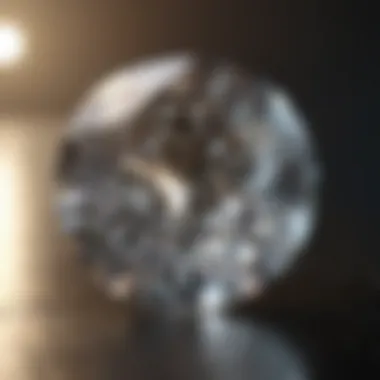
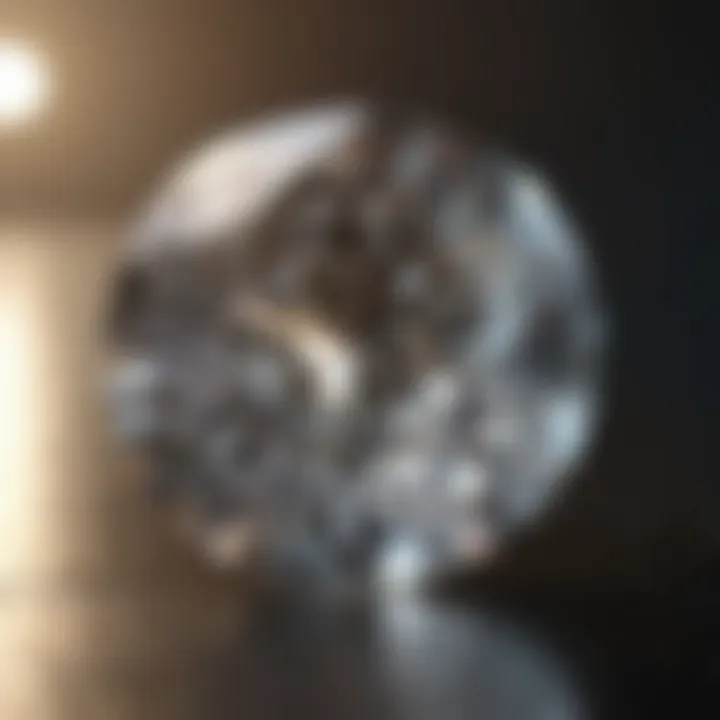
Depth percentage is a metric used to define how deep a round diamond is in relation to its diameter. It is calculated by dividing the depth of the diamond by its diameter and then multiplying by 100 to get a percentage.
For instance, if a diamond has a depth of 5 millimeters and a diameter of 6 millimeters, the calculation would be:
[\textDepth Percentage = \left( \frac56 \right) \times 100 = 83.33% ]
A depth percentage between 60% and 62% is commonly considered ideal for round diamonds. Diamonds falling within this range typically showcase optimal light performance. They reflect light effectively, resulting in a higher brilliance and sparkle. Alternatively, a depth percentage that is too low can suggest that the diamond may allow light to escape from beneath, while values that are excessively high can lead to a cloudy appearance due to light dispersal.
Depth in Relation to Diameter
The relation of depth to the diameter of a diamond is crucial for a diamond’s proportions. The diameter is the maximum width of the stone, and the depth contributes to its overall appearance. As a rule of thumb, for round diamonds, the ideal depth should balance with the diameter to produce an attractive and functional gem.
When assessing any round diamond, it is beneficial to consider the overall proportions. If the depth appears too pronounced compared to the diameter, the resulting shape may look less appealing. Conversely, a shallow depth can cause the diamond to lack character and appear flat.
- Proportions to Consider:
- Ideal Depth: 60%-62%
- Minimum Depth for Good Performance: 55%
- Maximum Depth Before Light Performance Suffers: 68%
Understanding how depth interacts with diameter will inform decisions, ensuring a balance that promotes not only beauty but also brilliance. Ultimately, the diamond's depth in line with its diameter forms the foundation for evaluating its overall cut quality, cementing its position within the realm of desired gemstones.
"A diamond's unique beauty is intrinsically connected to its structure, where depth and diameter play a crucial role in determining visual appeal."
By keeping these insights in mind, one can feel more equipped to assess and appreciate the qualities of round diamonds and their ideal depths.
Measuring Depth for Round Diamonds
Determining the ideal depth for round diamonds is essential in evaluating their beauty and value. The depth measurement is a critical variable that influences how light interacts within the stone. Accurately measuring depth unveils insights into the diamond's overall brilliance and performance. By understanding how to measure depth, buyers can ensure they are selecting gemstones that meet their aesthetic preferences and practical requirements.
Standard Measurement Techniques
The traditional method of measuring depth involves using calipers to get precise dimensions. You start by measuring the total height of the diamond from the culet to the table. This measurement is then often divided by the stone's diameter to calculate the depth percentage. A common method is to use a gemological microscope, which offers high magnification and clarity. This instrument allows a jeweler to see minute details and ensure accurate depth calculations.
Additionally, there are simple steps one can follow to perform this measurement:
- Measure the diameter of the diamond at its widest point.
- Measure the depth from the table to the culet.
- Calculate the depth percentage using the formula:
Depth Percentage = (Depth / Diameter) x 100
This method provides a critical benchmark that can be referenced against ideal depth ranges for round diamonds, typically falling between 43% and 58%.
Using Advanced Tools and Technology
Modern advancements in technology have revolutionized how depth is measured in diamonds. Tools like laser measuring systems and computer-aided design technology allow for increased accuracy. Lasers provide precise measurements without the risk of human error, which can occur with manual techniques.
Some notable technologies include:
- Scanning Electron Microscopes: These devices create detailed images at the microscopic level. They can help identify subtle differences in the depth of facets that may influence light performance.
- Laser Scanners: These sophisticated tools provide a complete 3D profile of the diamond. This technology can measure depth with exceptional precision and offer a holistic view of the gemstone.
Engaging with these tools not only increases measurement accuracy but also enhances the understanding of how various facets interact with light. In the competitive market of gemstones, having access to such advanced tools can distinguish exceptional diamonds from average specimens.
Recommended Depth Ranges
Understanding recommended depth ranges is fundamental when evaluating round diamonds. This aspect is important because the depth directly affects how light interacts with the stone, influencing brightness and overall visual appeal.
In general, the ideal depth percentage for round diamonds is between 43% to 58%. Staying within these parameters can enhance the diamond's brilliance and fire. When the depth is too shallow or too deep, light can escape, reducing sparkle. Therefore, buyers should consider these ranges seriously to ensure they choose a diamond that reflects maximum light.
Ideal Depth Percentages
Ideal depth percentages vary slightly based on the stone’s cut quality and individual preferences. Typically, a depth percentage of around 55% is often deemed optimal for many round diamonds. This percentage strikes a balance between light reflection and absorption, providing the best compromise for visual attraction.
- 43% to 45%: Stones in this range tend to be shallow. While they may look bigger due to a larger table size, they often lack brilliance.
- 46% to 54%: This zone is preferred by many. These diamonds maximize brilliance while also ensuring a substantial appearance on the finger.
- 55% to 58%: Closer to the upper limit, these diamonds often reflect light beautifully but can be slightly deeper. A buyer should inspect this closely to assess overall brilliance.
Variations by Shape and Cut
The recommended depth cannot be viewed in isolation, as it varies depending on the shape and cut of the diamond. For instance, different shapes such as princess and oval diamonds have different ideal depth percentages. Understanding these variations is crucial for informed decision-making.
- Princess Cut: Ideal depth ranges are between 68% to 72%. Since this shape has more facets, the depth creates a distinct visual appeal.
- Oval Cut: Here, a depth percentage of around 58% is favorable. This allows for the elongated shape to appear elegant while maximizing brilliance.
- Emerald Cut: Typically, the depth for emerald cuts should be lower at 61% to 63%. This is due to its step-cut design, which relies more on clarity and color than on brilliance.
Impact of Depth on Brilliance
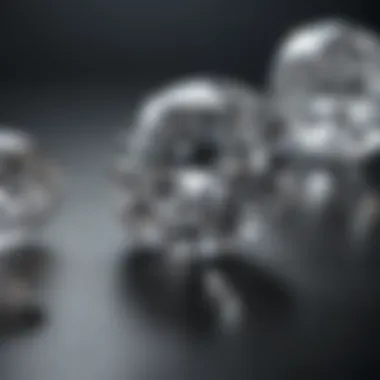
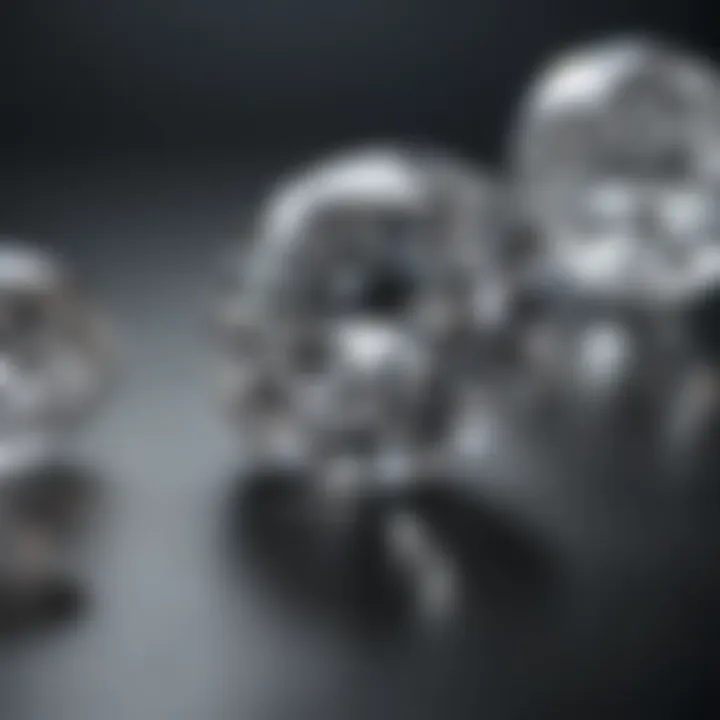
The depth of a round diamond plays a pivotal role in its overall brilliance and visual appeal. A diamond's cut is not limited to its shape; it also encompasses how light interacts with the stone. Therefore, understanding how depth affects brilliance is essential for anyone looking to purchase or appreciate round diamonds. Depth impacts light performance, which in turn influences the fire and sparkle of the stone.
How Depth Affects Light Performance
When evaluating a round diamond, one must consider how depth impacts its interaction with light. Ideally, a well-proportioned diamond allows light to enter through the table and reflect off the internal facets before exiting back through the top. The depth percentage, defined as the ratio of the diamond's total depth to its diameter, directly influences this light performance.
- A depth that is too shallow can lead to excessive leakage of light. This means less brilliance and overall impact.
- Conversely, if the depth is too deep, light may enter but not reflect properly, again resulting in reduced sparkle.
An optimal depth typically ranges from 59% to 62% of the diameter, balancing the light entry and exit, thus maximizing brilliance. Adhering to this range ensures that the diamond sparkles beautifully under various light conditions.
Depth and its Effect on Sparkle
Sparkle, often referred to as the "play of light," is the visible effect created by light interacting with the diamond's facets. The depth of the diamond influences how this interaction occurs. Good depth allows for the maximum return of light, creating a dazzling display.
- Too Shallow: Diamonds with insufficient depth may produce a washed-out or dull appearance, leading to minimal sparkle. These stones tend to reflect light out of the sides rather than the top.
- Too Deep: On the other hand, deeper diamonds can suffer from a blocked-out look. Added depth causes light to absorb rather than reflect, failing to create that desired sparkle effect.
A diamond's brilliance is a harmonious blend of both cut and light performance, with depth being a crucial component in this dynamic.
Analyzing the Depth-to-Table Ratio
Exploring the depth-to-table ratio is essential when assessing round diamonds. This measurement significantly influences a diamond’s overall visual appeal and performance. The depth corresponds to the stone's height relative to its diameter, while the table refers to the flat surface on top of the diamond. Understanding their relationship helps in identifying optimal proportions for desired light performance and aesthetic qualities.
The depth-to-table ratio provides insight into how light travels through the gemstone. Ensuring this ratio is within recommended ranges can greatly enhance the diamond's brilliance and sparkle. A careful analysis helps buyers make informed choices, as different ratios can convey various visual effects and perceptions of quality.
What Does Table Size Indicate?
The table size of a round diamond is a critical element that influences its optical characteristics. Specifically, it represents the upper facet, and it directly affects how light interacts with the stone. A larger table size can lead to an increased amount of light entering the diamond, which may enhance brilliance. However, if the table size is too large in relation to the depth, it may cause a loss of fire – that is, the colorful flashes seen when light disperses.
Common table size values range between 52% to 62% of the diamond's diameter. A table that is roughly 55% can be considered ideal for many round diamonds, striking a balance between brilliance and fire. Buyers should be aware that deviations from these proportions may lead to less desirable results.
Optimal Ratios for Enhanced Visuals
Finding the optimal depth-to-table ratio is crucial in enhancing a diamond's visual qualities. In general, an ideal range is suggested to fall between 60% to 62% depth relative to a table size of about 55%. This balance allows both aspects to work harmoniously, maximizing light performance.
A well-balanced ratio can lead to:
- Enhanced Brilliance: Proper proportioning allows for light to enter and reflect appropriately.
- Optimal Fire: Aesthetic display of color can significantly elevate the stone's appeal.
- Improved Symmetry: This ties into overall cut quality, contributing to the visual uniformity of the diamond.
Selecting diamonds requires careful consideration of these metrics. Lack of attention to the depth-to-table ratio may lead to visual compromises that affect perceived value.
"Understanding the depth-to-table ratio is fundamental for anyone looking to make a significant investment in round diamonds."
In summary, the depth-to-table ratio serves as an important framework for assessing round diamonds. By comprehending the implications of table size and finding the optimal ratios, buyers can better navigate the complexities of diamond evaluation.
Critical Crown and Pavillion Angles
Understanding the crown and pavilion angles of a round diamond is essential for assessing its overall aesthetic value and brilliance. These angles influence how light refracts within the diamond, which directly impacts how the stone sparkles. Getting these angles right can mean the difference between a visually stunning diamond and a lackluster one.
The crown refers to the upper portion of the diamond, containing facets that contribute to the stone's brilliance. The pavilion is the lower section, which helps reflect light back to the observer. Together, they play a crucial role in the cut quality of the diamond. A balance between these angles ensures optimum light performance, enhancing the diamond's appeal.
Understanding the Angles
The crown angle typically sits between 28 to 35 degrees. An angle within this range optimally refracts light, maximizing its return to the viewer's eye. Conversely, if the crown angle is too shallow, the light leaks out, reducing brilliance. A steep angle, while potentially giving a more dramatic appearance, can fracture the light initially and dim the diamond’s sparkle.
The pavilion angle usually ranges between 40.6 to 41.8 degrees. This angle's precision is just as important. An ideal pavilion angle captures light and reflects it effectively, contributing to the stone's overall luminosity. When the angles of both the crown and pavilion are properly calculated and aligned, they create synergy that enhances the diamond’s beauty.
How Angles Affect Overall Appearance
The interactions between the crown and pavilion angles also influence the visual perception of the diamond's size and brilliance. A well-proportioned diamond tends to look larger and more brilliant, while imbalanced angles can make a stone seem smaller or duller. Light behavior within the diamond results in distinct visual characteristics, often categorized as brilliance, fire, and scintillation.
Brilliance reflects white light, with the most visually arresting diamonds showing superior brilliance. Fire refers to the spectrum of colors exhibited when light is dispersed through the stone. Finally, scintillation describes the sparkle created by light reflections from the diamond's facets.
"The relationship between the crown and pavilion angles is critical for achieving a diamond that captivates."
When selecting a diamond, pay attention to these angles on the diamond report, as they illustrate how the diamond has been cut. An understanding of these measurements equips buyers with the insight needed to make informed choices when purchasing round diamonds.
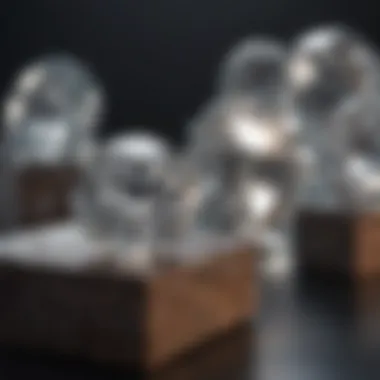
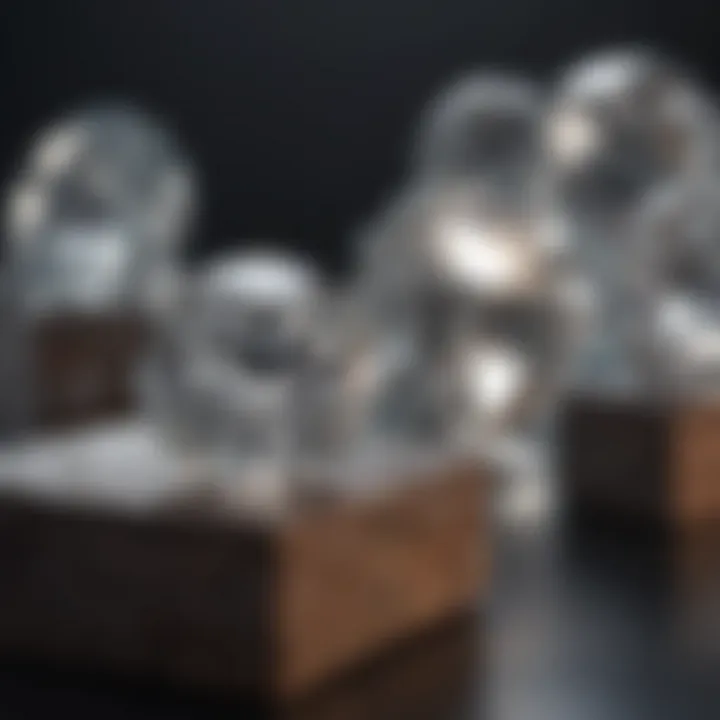
Common Misconceptions About Depth
Understanding the common misconceptions about diamond depth is essential for those looking to invest in round diamonds. These misconceptions can lead to poor purchasing decisions and misunderstandings about what depth truly represents in terms of a diamond’s beauty and overall value.
A lot of potential buyers equate depth with weight, assuming that a deeper diamond must be more valuable. However, this is simply not true. More important is how well the depth contributes to the diamond's brilliance and sparkle. Not grasping this can result in choosing a stone that looks less visually appealing, despite perhaps having a higher carat weight.
Additionally, some believe that all deep diamonds are unattractive; this too is a myth. A diamond's overall cut quality can still achieve excellent brilliance with certain depth percentages. Knowledge of these misconceptions can empower buyers, enabling them to evaluate diamonds with a critical eye.
"Misunderstandings about depth can lead to missed opportunities for acquiring stunning diamonds."
Myths Around Depth Values
One prevalent myth is that any diamond with depth exceeding a certain percentage is automatically inferior. This arbitrary cutoff often leads to overlooking diamonds that might possess unusual beauty. The depth percentage needs to be viewed in conjunction with other factors like table size and crown angle.
Another misconception is that the ideal depth percentage is universally the same for all round diamonds. In reality, variations exist based on personal preference and individual stone characteristics. A buyer's preference should dictate the ideal depth rather than a one-size-fits-all guideline. Understanding these nuances helps prospective buyers to keep an open mind, potentially finding a diamond that captivates them, even if it does not strictly adhere to so-called ideal depth metrics.
Clarifying Depth vs. Weight
Many people mistake depth for weight, thinking a heavier diamond must equate to a more attractive stone. However, it's crucial to clarify this distinction.
Depth refers specifically to the vertical measurement from the table to the culet. In contrast, weight is determined by the mass of the diamond, typically measured in carats. Therefore, a diamond might have a deep cut which looks larger due to its depth, but it does not necessarily mean it is of higher quality or value. Buyers should focus on depth characteristics rather than simply carat weight.
It is also important to consider that two diamonds can weigh the same but have vastly different depths. This can result in one diamond appearing much larger than the other due to how the light interacts with its facets. Therefore, understanding the mechanics behind depth versus weight is vital for making informed decisions in diamond purchasing.
Evaluating Round Diamonds: A Buyer’s Guide
When purchasing a round diamond, understanding the significance of depth is essential. Depth influences not just the appearance of the stone but also its brilliance and overall quality. As a buyer, being informed about what depth means in the context of a diamond can dramatically enhance the buying experience. This guide provides critical insights for anyone looking to evaluate round diamonds effectively.
Evaluating depth within a diamond involves considering various aspects, specifically how depth interacts with other measurements such as table size and angles. Buyers should recognize that a diamond is a product of many precise measurements and evaluations. A well-informed choice guarantees satisfaction, both in aesthetics and investment value.
What to Look For When Evaluating Depth
To assess the depth of a round diamond accurately, focus on the following areas:
- Depth Percentage: This is calculated by taking the total depth of the diamond and dividing it by its diameter, then multiplying by 100. Ideal percentages typically range between 60% and 62.5%. A depth percentage that aligns with these figures can enhance visual appeal.
- Measurement Techniques: Be aware of the standard practices to measure depth. The most common methods rely on precise instruments to ensure that measurements are both accurate and reproducible.
- Depth-to-Table Ratio: This ratio indicates the depth proportionate to the diamond's table size. A well-balanced ratio can enhance sparkle and visual attractiveness. Seek information on optimal ratios recommended by experts in the industry.
- Crown and Pavilion Angles: These angles influence how light interacts with the diamond. Understanding the implications of these angles on depth can help buyers make more informed choices.
Using these criteria will enable buyers to gauge whether a diamond’s depth corresponds with their expectations in quality and appearance.
Questions to Ask Your Jeweler
Engaging with a jeweler can provide vital information regarding a diamond's depth. Here are some essential questions to consider:
- What is the depth percentage of this diamond?: Knowing the specific depth percentage will allow you to understand its fit within the accepted ideal ranges.
- Can you explain how this depth affects the diamond’s brilliance?: This question can clarify the relationship between depth and light performance, informing whether this diamond would meet your aesthetic desires.
- What are the crown and pavilion angles?: A professional can provide details about these angles and how they relate to the diamond's overall visual impact.
- Is there a grading report available?: Requesting certificates from organizations like the Gemological Institute of America (GIA) helps ensure that you are purchasing a certified product, complete with detailed evaluations of depth and other characteristics.
- How does this diamond compare to others in terms of depth?: Understanding how a particular choice stacks up against alternatives can provide reassurance about your decision.
By asking these targeted questions, you can better assess a round diamond's quality and suitability for your needs.
Knowledge about depth enhances decision-making in purchasing round diamonds, helping to ensure both quality and satisfaction.
Depth Preferences in Different Gemstone Cultures
Understanding depth preferences in various gemstone cultures is essential for comprehending how regional influences shape perceptions of diamond aesthetics. Diamonds, particularly round ones, are not only viewed as symbols of status but also as manifestations of cultural identity and values.
Different cultures possess unique values regarding gemstones, which translate into specific preferences for depth in diamonds. For instance, in some cultures, deeper diamonds may be prized for their weight and perceived value, whereas others might favor shallower cuts that optimize brilliance and radiance. This divergence often leads to varying definitions of what is considered an ideal depth across the globe.
Cultural Influences on Perception of Depth
Cultural beliefs significantly influence how depth is interpreted and valued in diamonds. In cultures where wealth and opulence are highly regarded, deeper diamonds may be favored. The conventional wisdom might suggest that more depth equates to greater volume and therefore a higher perceived worth.
In contrast, cultures that prioritize light performance and visual appeal often advocate for shallower proportions. They recognize that with the right proportions, light can enter and exit the diamond more efficiently, enhancing its brilliance. These cultural nuances lead to different buying habits and preferences, which can often be seen in local jewelry markets.
"Depth preferences for diamonds may vary significantly based on cultural perceptions of beauty and value."
When examining depth through a cultural lens, it becomes apparent that the ideal depth is subjective. Factors such as gender roles, economic status, and historical context play a role in shaping these preferences. A deeper understanding of these factors empowers buyers to appreciate the cultural background of their choice.
Variability in Cutting Styles Across Cultures
The cutting styles employed by different cultures also reflect their depth preferences. In regions like Europe, where tradition merging with modern techniques is prevalent, jewelers tend to cut diamonds that maximize both depth and brilliance. The resulting gems often display a balance that appeals to the European aesthetic.
Alternatively, in regions where innovative cuts were pioneered, such as in the United States, there tends to be a focus on achieving a specific depth that enhances light reflection. Here, contemporary designs often prioritize brilliance over carat weight, leading to shallower cuts which can yield visually stunning diamonds.
Each cutting style embodies cultural values, preferences, and artistry. Buyers should consider these variances when selecting diamonds, as cultural influences might shape their expectations of depth, brilliance, and overall beauty. Understanding these differences not only enriches the purchasing experience but also fosters greater appreciation for the artistry involved in diamond cutting.



